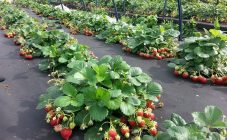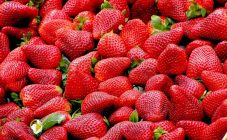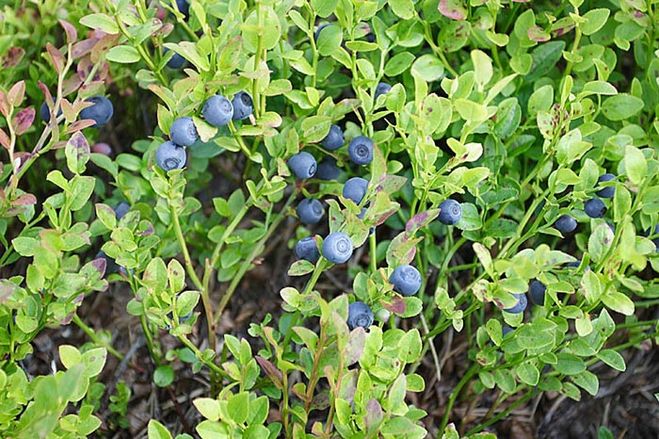Content:
The favorite of many - wild strawberry - has been known for thousands of years as a fragrant medicine for many diseases. The whole plant, from berries to roots, has medicinal properties. In late spring - early summer, many go to the forest to pick berries and leaves of strawberries. And although this is a lot of work, it is fully justified.
Description of culture
Wild strawberry, or common strawberry, is a plant of the Rosaceae family. It is often confused with strawberries. And although they are from the same family, they have differences that are imperceptible at first glance: dioeciousness, the placement of flowers over the leaves, aroma and other features.
Strawberries up to 30 cm high, have a thick rhizome with brown stipules. Long filamentous shoots - whiskers, which take root at the nodes, extend from the roots. In their place, rosettes of basal leaves appear and flowering stems grow. Due to them, the plant has the ability to reproduce.
Strawberry leaves are dark green above, bluish green below. Flowers are five-membered, bisexual, white, collected in corymbose inflorescences. Fruits (often by mistake popularly called a berry) are multi-nut due to the pulp with small nuts immersed in it.
It is known from history that strawberries appeared in Europe during the Middle Ages. She was brought from Chile, and she came to Russia at the end of the 18th century. Today there are more than 2000 varieties of strawberries. All are very popular due to the chemical composition of the body. So, the leaves contain:
- B vitamins;
- ascorbic acid;
- carotenoids;
- organic acids;
- Sahara;
- essential oils;
- flavonoids;
- tannins;
- salts of iron, cobalt, manganese and phosphorus.
The leaves of the plant are collected, dried and made from them decoctions, which have proven themselves well as a diuretic for cholelithiasis, diabetes or anemia. Tea from them is taken for sore throats, coughs, for the prevention and enhancement of immunity. Strawberries are good fresh and dried, as well as face masks.
It is worth remembering that strawberries have minor contraindications. Fresh fruits are not recommended for people with high acidity, intolerance or allergic reactions.
Wild strawberries can be found in almost every region of the country. For reproduction, the plant chooses lightened forests, edges near the forest belt and plantings.
During the growing season, wild strawberry goes through certain stages of development. In spring, when the temperature is from 2 to 5 ° C, the plant grows. This is due to nutrients that have been deposited in the overwintered stems and leaves. Strawberry varieties can be early flowering and late flowering. Also, the flowering period will depend on the growing region.
After harvesting, the bushes begin to grow abundantly: the plant overgrows with leaves and mustaches. But, if at this time you ignore the abundant watering of strawberries, then the bushes that have started to grow will immediately slow down their development.The process will resume only in September, when the heat subsides and precipitation falls. Thus, the plant stores up nutrients before winter and differentiates fruit buds.
When strawberries appear in the forest
Newbies in berry cultivation are often interested in the question of when strawberries ripen in the forest. For example, in the Moscow region, the ripening time will depend on the variety and place of growth. So, in the forests, berries begin to ripen in the middle, at the edge - at the end of July. In the Leningrad and Orenburg regions, you can go for strawberries in June.
Many are upset that they do not have time to collect berries when wild strawberries ripen. But there is no reason for panic, since strawberries bear fruit for 1-1.5 months. At the beginning of the harvesting season, it is worth looking for berries on the southern edges of the forest and clearings, on the edges, and then in the depths of the forest.
The fruits of wild strawberries are collected by hand; no devices and mechanisms have been invented for this process.
To go to the forest to pick berries, you should dress properly and take with you the appropriate utensils for fruits (a bucket, a bowl, but not a bag, as strawberries will be crumpled and lose their taste). The best time to harvest is early in the morning after the dew has melted or in the evening when the heat subsides. It is worth refraining from picking strawberries in the rain, because wet berries spoil and wrinkle faster.
The process of picking strawberries is not easy. It will not work to find it just by looking at your feet, you need to kneel, push the leaves with your hands in search of berries. It is worth picking only a ripe berry, which is easily separated from the stalk.
When collecting wild strawberries, it is worth remembering simple safety rules:
- do not eat unfamiliar berries and fruits;
- dress as closed as possible to avoid tick bites;
- take a communication device with you;
- have a map or navigator.
The nuances of growing wild strawberries in the garden
Recently, gardeners very often refuse to grow wild strawberries in their garden, since large-fruited garden varieties are considered more attractive. However, there are those who still consider wild strawberries to be more attractive, unpretentious, disease-resistant plant. It is also great for the Moscow region climate.
Planting strawberries in your garden takes place in several stages:
- Preparing the soil at the site for planting.
- Preparation of strawberry seedlings.
- Planting seedlings in open ground.
- Further care of seedlings.
During the first stage, it is important to find the most favorable area for strawberry growth. Experienced gardeners do not recommend planting wild strawberries on elevations, since in winter strong frosty winds will blow there, and the plant will freeze out. The soil should be slightly acidic, neutral with an optimal amount of humus. Approval must be made to the selected site: manure, compost or humus, superphosphate and potassium sulfate. Then everything is dug up and left for the winter. In the spring everything is dug up again.
At the second stage, annual or biennial strawberry bushes are found in the forest, the first and second rosettes are taken from their whiskers. It is worth taking those whiskers that are closest to the mother plant, as they take root faster and will have a higher yield. Then they are planted for growing on the bedding beds. During this period, it is important to monitor and care for the seedlings: water, weed and loosen the soil.
At the beginning of September, the next stage begins: the seedlings are planted in open ground. Each seedling is placed at a distance of 30 cm from each other. A depression is created, a plant is lowered into it, covered with earth and pressed tightly with your hands.
After planting, caring for strawberries does not end. It is necessary to monitor the growth of seedlings and properly care for them: remove weeds, water, loosen the soil, mulch the soil so that moisture remains in the soil longer. In spring, all dry leaves of the plant are removed.
Also, wild strawberries should be fed regularly. The first feeding of mullein, superphosphate and wood ash is carried out in late April - early May. The second time you need to feed it with wood ash and superphosphate before flowering. Further, strawberries are fed with ammonium nitrate or ammonium sulfate after harvest. Its composition can be replaced with a diluted slurry fertilizer. The last time of the year, fertilizing is carried out in late August - early September with mineral fertilizers. Superphosphate and potassium salt are suitable for these purposes.
Year-round harvest of forest strawberries at home
For gardeners without a summer cottage there is an option for growing strawberries in their own apartment. To do this, you can simply plant the seedlings in special pots and place them on a window or balcony. It will serve as an ornamental plant during flowering and produce healthy, tasty berries. If proper care is carried out, the yield from one bush of a small-fruited variety will be 100-200 berries per year, and from a large-fruited one - more than 700. Such strawberries bloom all year round, and the first berries will give 2 months after planting in a pot.
How to plant wild strawberries at home? Sometimes the climate, for example, in the Moscow region, does not allow growing strawberries in a summer cottage all year round, but it is possible to do this in an apartment. There is a whole scheme for this.
Large ripe berries are selected and rubbed through a sieve, washed with a glass of water, settled, after the pulp is drained, and the seeds are dried on paper. A drainage layer of fine gravel, shards, charcoal is poured into the pot for planting at the bottom. Then leafy earth, humus, sand are laid in layers. All this is watered and seeds are sown on top. The pot is covered with a dark cloth and placed in a dark place. After periodically it is gently watered with warm water.
After 2 weeks, the first shoots begin to appear. The pot is covered with glass or transparent film and placed on the window. When the seedlings grow up to 1 cm, they are transplanted into a larger box at a distance of 5 cm from each other. After the plant has 5-6 full-fledged leaves, the bushes are once again transplanted 2-3 pieces into a pot. Young plants are watered from time to time and fed with micronutrient fertilizers.
It is better to keep strawberries on a window on the sunny side, pour water at room temperature, but avoid waterlogging. It is also worth feeding 2-3 times a month with liquid fertilizers. When the plants start to bloom, you need to pollinate them, this can be done with a paintbrush.
Signs of strawberry mite infestation:
- bushes are underdeveloped;
- leaves become small, wrinkled and strongly corrugated with a yellowish tinge and a silvery bloom;
- the berries dry out.
You can fight the strawberry mite with an infusion of onion peels, treating the bush at the beginning of the growing season and a couple of times after picking berries.
Strawberry sawflies eat out oval-shaped holes in the leaves of the plant. The fight against them occurs with the help of insecticides. To prevent sawflies, you need to dig up and loosen the ground under the strawberry bushes and get rid of weeds.
The main diseases of strawberries are gray rot or powdery mildew. Gray rot is treated with a mixture of wood ash and copper sulfate with water. Powdery mildew is a fungal disease that can be treated with fungicides.Further propagation of strawberries at home is done with a mustache.
Perhaps today you cannot find a person indifferent to the strawberry taste, especially if the opportunity to eat the berry is provided all year round. Anyone will be pleased when in winter, during flowering, the plant fills the house with a wonderful aroma, and later gives a healthy harvest, rich in vitamins. This is a hardy and unpretentious plant, so reproduction and planting at home and at their summer cottage will not cause great difficulties even for novice gardeners.
















